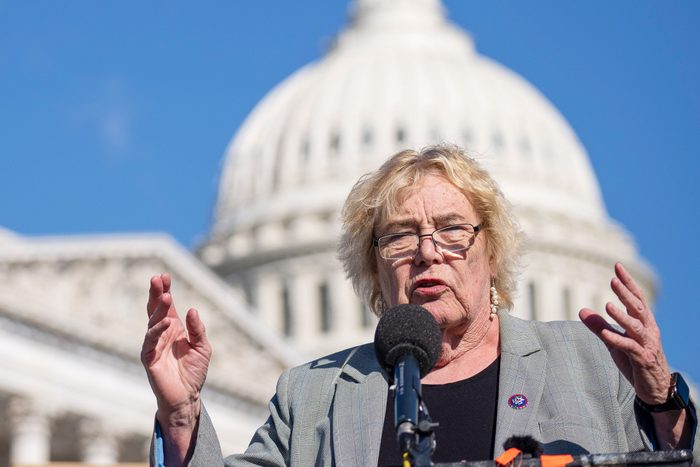What Is the Electoral Count Act—and Why Did the House Vote to Reform It?
Updated: Feb. 15, 2023

Updating the 135-year-old Electoral Count Act could help safeguard future presidential elections. Here’s how.
The Reader’s Digest Version
|
Free and fair elections, along with peaceful transfers of power, are bedrocks of American democracy. Another critical feature is our ability to vote for representatives who have the power to create new laws, amend the Constitution and update existing legislation that no longer works. Given that some of the country’s laws are more than 200 years old, new legislation and Constitutional amendments can be used to address issues that weren’t originally considered, like preventing voter suppression or what to do if a president won’t leave office. That’s what’s happening right now with the Electoral Count Act of 1887.
In an attempt to safeguard future presidential elections, both the U.S. House of Representatives and the Senate have legislation in the works that would make multiple changes to the Electoral Count Act. The House was the first out of the gate, passing their version of the bill—the Presidential Election Reform Act—on Sept. 21 with bipartisan support.
While this is not the first attempt at reforming the Electoral Count Act, the circumstances are different this time. “The main reason for the newfound attention from legislators is the aftermath of the 2020 election,” says Jim Ronan, PhD, a political science professor at Villanova University. “Once attention turned to recounts and audits following Election Day, many were surprised to learn just how little federal oversight is provided when it comes to the Electoral College.”
Now that the congressional wheels are in motion and midterm elections are right around the corner, it’s a good time to take a closer look at the Electoral Count Act. We asked government experts to walk us through exactly what it is, how legislators want to change it and what it means for the future of the United States.
What is the Electoral Count Act?
The Electoral Count Act of 1887 is a federal law that provides guidelines for counting electoral votes in a presidential election. It was created in response to the 1876 presidential election between Samuel Tilden and Rutherford B. Hayes—in which four states had internal disagreements about the outcome of their popular vote, which initially left the election undecided—and the multiple elections decided by razor-thin margins that followed. In short, Congress passed the Electoral Count Act “to deal with disputed elections in the states to prevent a future crisis from emerging,” Nicholas B. Creel, PhD, a political scientist and an assistant professor of business law at Georgia College and State University, tells Reader’s Digest.
How the electoral process works
Before we go any further, let’s take a step back and review the presidential election process. When Americans head to the polls on presidential election days, we’re not voting for the presidential candidate directly, but rather, for the candidate’s preferred electors in our state. The number of electors in each state varies, corresponding to its total number of senators and representatives in Congress. In 48 states, the candidate who wins the state’s popular vote receives all the electors; in Maine and Nebraska, electors are awarded based on the proportion of the state’s popular vote that each candidate receives.
This brings us to the Electoral College, which, despite how it sounds, is a process, not a place. The selection of the electors in each state—which happens on or after Election Day in November—is the first step of the process. After that, the electors meet in their state in mid-December to cast their votes for president and vice president. The electoral votes are counted once, by Congress, on Jan. 6.
What the Constitution left out
While Article II of the Constitution established the Electoral College, it didn’t differentiate between candidates running for president and vice president—meaning that the candidate with the highest number of votes became president and the runner-up became vice president. That changed after the ratification of the 12th Amendment in 1804, which required electors to separate their votes, specifying their selections for president and vice president.
Why the 12th Amendment wasn’t enough
Unfortunately, neither the Constitution nor the 12th Amendment were much help during the undecided election of 1876. “In the short term, a committee was created that ultimately gave the election to Hayes,” says Ronan. “But long-term guidelines were clearly needed, which led to the Electoral Count Act.” Though the legislation changed the electoral process, it was not itself a constitutional amendment, but rather a statute approved by both the House and the Senate, and signed into law by President Grover Cleveland on Feb. 3, 1887.
Overall, the 1887 Electoral Count Act conformed to the 12th Amendment, which required Congress to certify the electoral votes of each state. “However, it left nearly all the power to individual states concerning how their electoral votes were certified,” Ronan explains. “Therefore, Congress’s role was relegated to merely counting the votes. This process has essentially remained unchanged since 1887.”
Why do some legislators want to reform the Electoral Count Act?
Though there has been some interest over the years in reforming the Electoral Count Act, the 2020 election and the events of Jan. 6, 2021, galvanized support for making changes to the 135-year-old law. “The Electoral Count Act is an outdated and ambiguous law that is in need of reform to ensure the protection of the public vote in each state,” says John P. Pelissero, PhD, senior scholar at the Markkula Center for Applied Ethics at Santa Clara University. That lack of clarity, he continues, is what allowed former president Donald Trump to pressure then–Vice President Mike Pence to reject the electors from a handful of states where he disputed the election results.
Trump claimed—without evidence—that these states saw high rates of election fraud and that if the allegedly fraudulent votes were thrown out, he would emerge as the clear winner. “While most legal scholars agree that the vice president’s role is purely ceremonial, [the Electoral Count Act of 1887] doesn’t explicitly say that he is without the authority to reject what he deems as fraudulent slates of electors,” Creel explains. If Pence had tossed out those electors, “nobody would have won a majority of votes in the Electoral College, meaning the House of Representatives would elect the president in a state delegation vote, which favored Republicans.”
As a result, recent calls for reform of the 1887 Electoral Count Act have centered on clarifying how the electoral results of states are certified and counted by Congress for presidential elections, says Kevin Pallister, PhD, associate professor of political science at Bridgewater College. Lawmakers also want to explicitly state that the vice president’s role in the counting of the 538 electoral votes is entirely ceremonial and comes with no authority to alter the election results.
State guidelines surrounding presidential elections—or the lack thereof—are also in the crosshairs. “The 1887 Act requires states to certify and deliver their electoral votes without any real oversight concerning elections,” Ronan explains. On top of that, the Electoral Count Act allows members of Congress to object to the certification of a state’s electoral votes but doesn’t require any burden of proof for such a claim. “As a result, any member of Congress can raise an objection and potentially delay the electoral vote count based solely on personal or political motivations,” he notes.
What does the 2022 Presidential Election Reform Act do, exactly?
According to Pelissero, if it were to become law, the 2022 Presidential Election Reform Act would make four notable changes to the electoral process:
- It would require that each state’s governor be the only official who can submit the certified slate of that state’s electors and votes.
- It would affirm that the vice president’s only role in the electoral count is to preside over the joint meeting of Congress in which the votes are announced.
- It would raise the requirement to object to state electors’ votes being counted from the current rule of one member of Congress to at least one-fifth (or even one-third) of the combined House of Representatives and Senate (535 members).
- It would remove the possibility that a state legislature could attempt to install an alternative slate of electors by declaring a “failed election” in that state.
Will the reform act abolish the Electoral College?
If the Presidential Election Reform Act becomes a law, it would not abolish the Electoral College. Because the Electoral College is established in the Constitution, it would take a constitutional amendment to do away with it. And while the Presidential Election Reform Act isn’t an amendment, there have been more proposals for constitutional amendments to change the Electoral College than on any other subject, according to the National Archives.
“The two most important reasons why people want to end the Electoral College method is that it can deny the presidency to the winner of the popular vote—as happened in 2000 and 2016, and almost in 2004 as well—and that it makes the election turn on only a handful of swing states, which motivates manipulation of the election systems in those states,” explains John Davenport, PhD, professor of philosophy at Fordham University and author of the upcoming book The Democracy Amendments: A Program for Constitutional Reform. “A direct popular vote avoids all the problems considered by the pending bills and is much easier for the public to understand.”
But while the Electoral College has its detractors, Pallister says that it’s probably not going away anytime soon. “The Electoral College is criticized for a variety of reasons,” he notes, “but there is no major push right now to abolish it—or at least [one] that has any chance of succeeding in the short term.”
Who supports the Election Reform Act?
Representatives Zoe Lofgren (D-CA) and Liz Cheney (R-WY) introduced and co-sponsored the Presidential Election Reform Act, which passed in the House of Representatives, 229–203, with bipartisan support. All Democrats—and nine Republicans—voted in favor of the bill.
Of the Republicans supporting the Electoral Count Act reform, eight voted to impeach Trump for his role in the Capitol attack. Another important note: None of the nine will be returning to their roles for the 118th Congress; four lost their primary races, and five have decided not to run for reelection.
What happens next?
Now that the Presidential Election Reform Act has passed in the House, it will move on to the Senate for approval—though that’s not guaranteed. “Under the current rules of the Senate, 60 senators are needed to support the bill in order for it to be called for a vote,” Pelissero explains. “Unless the Senate sets aside its filibuster process and agrees to take up this act under a simple majority vote, it is unclear, in the evenly divided Senate of 50 Democrats and 50 Republicans, whether the bill can advance.” Legislators likely won’t attempt this before the midterm elections, but proponents want it in place by the 2024 presidential election.
Meanwhile, the Senate has its own reform bill in the works—the Electoral Count Reform and Presidential Transition Improvement Act of 2022—which covers a lot of the same territory as the one from the House but isn’t identical. Senators Susan Collins (R-ME) and Joe Manchin (D-WV) introduced the bill, which, as of Sept. 21, has 10 Republican co-sponsors and 10 Democratic co-sponsors.
Though members of Congress aren’t universally in favor of electoral reform, the fact that both bills have gained bipartisan support at such a politically divisive time is a good indication that the current process needs to be fixed. “Overall, the proposed reforms would help to ensure that the ethical standard of fairness is protected in future counts of Electoral College votes,” says Pelissero.
Beyond that, Davenport points out that we need basic national standards that establish simple, easy and reliable ways of registering, voting and authenticating mail-in ballots. “Probably nothing [else] would be as valuable as this for the future of our country,” he says. “Democracy depends on cooperating with others who disagree with us—at least on some issues. That cooperation requires fair rules and the trust they foster.”
Sources:
- Congress.gov: “H.R.8873 – Presidential Election Reform Act”
- Jim Ronan, PhD, professor of political science at Villanova University
- Nicholas B. Creel, PhD, political scientist and assistant professor of business law at Georgia College and State University
- National Archives: “What is the Electoral College?”
- History, Art & Archives: “Electoral College Fast Facts”
- John P. Pelissero, PhD, senior scholar at the Markkula Center for Applied Ethics at Santa Clara University
- Kevin Pallister, PhD, associate professor of political science at Bridgewater College
- John Davenport, PhD, professor of philosophy at Fordham University and author of The Democracy Amendments: A Program for Constitutional Reform
- Congress.gov: “S.4573 – Electoral Count Reform and Presidential Transition Improvement Act of 2022”



